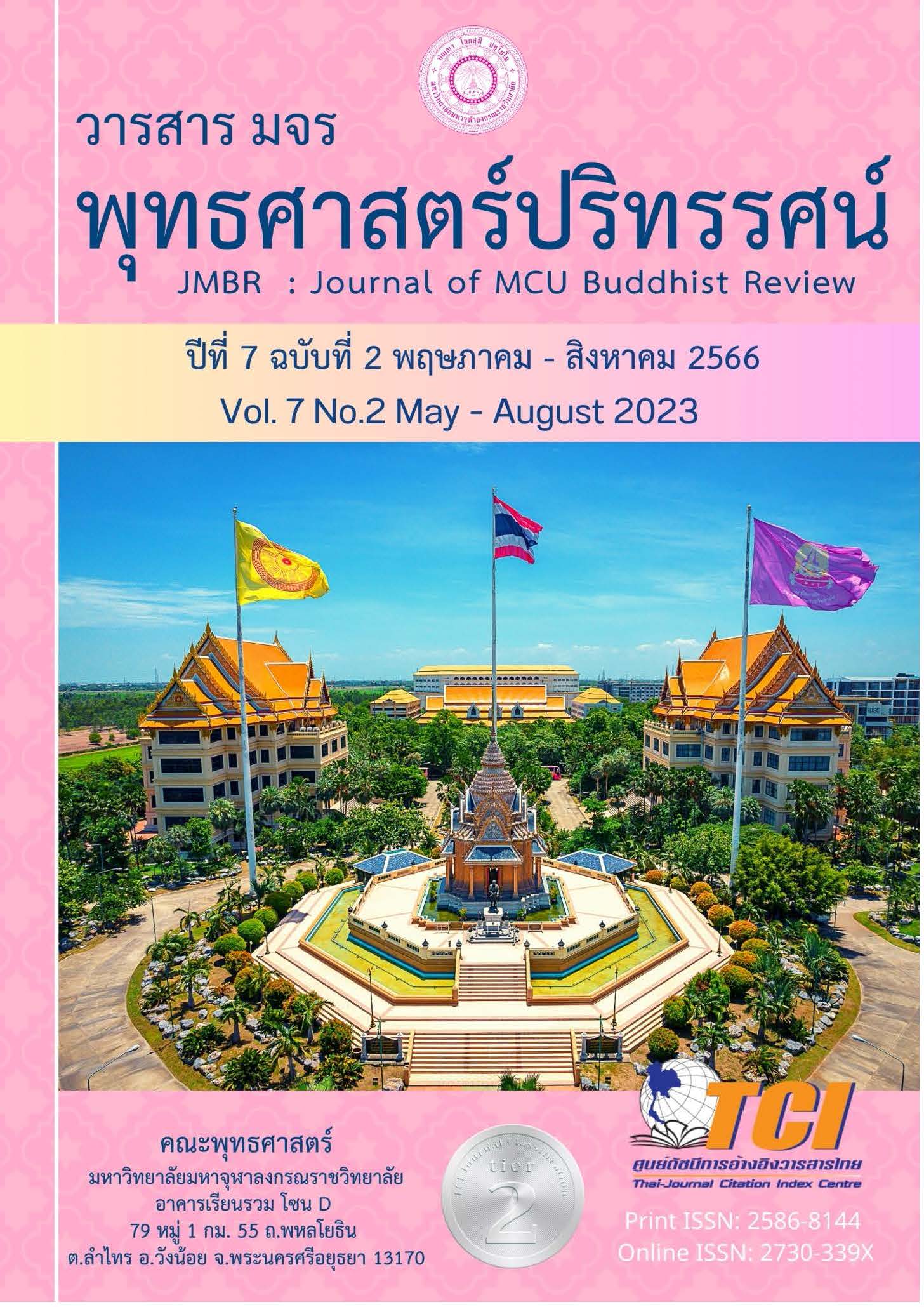ศึกษาวิเคราะห์กระบวนการสร้างสัมมาทิฏฐิในพรหมชาลสูตร
Main Article Content
บทคัดย่อ
บทความวิจัยนี้มีวัตถุประสงค์ 1) เพื่อศึกษาโครงสร้างและสาระสำคัญในพรหมชาลสูตร 2) เพื่อศึกษากระบวนการสร้างสัมมาทิฏฐิที่ปรากฏในพระไตรปิฎก 3) เพื่อวิเคราะห์กระบวนการสร้างสัมมาทิฏฐิในพรหมชาลสูตร เป็นการวิจัยเชิงคุณภาพ ด้วยวิธีการวิเคราะห์เนื้อหาจากข้อมูลในพระไตรปิฎก และเอกสารงานวิจัยที่เกี่ยวข้อง แล้วนำเสนอในรูปแบบเชิงพรรณนา
ผลการวิจัยพบว่า 1) พรหมชาลสูตรมีโครงสร้างและสาระสำคัญที่เนื่องมาจากสุปปิยพราหมณ์ กล่าวจาบจ้วงพระรัตนตรัย พระพุทธเจ้าจึงตรัสพรหมชาลสูตรว่า เหล่าพราหมณ์รับผัสสะไม่ถูกต้อง มีความยึดมั่นถือมั่น นำไปสู่มิจฉาทิฏฐิที่มีมูลเหตุ 62 ประการ บัญญัติอัตตาและโลกเพราะตัณหา ทำให้มีการเกิด ภพ ชาติ วนเวียนอยู่ไม่รู้จักจบสิ้น เหล่าสงฆ์ควรรับผัสสะให้ถูก ไม่โกรธ ไม่ดีใจ มีศีลบริสุทธิ์ 2) กระบวนการสร้างสัมมาทิฏฐิที่ปรากฏในพระไตรปิฎก มีเหตุปัจจัยมาจากปรโตโฆสะ เช่น กัลยาณมิตร ที่เป็นผู้แนะนำสั่งสอนเป็นผู้ชี้ทาง และ โยนิโสมนสิการที่เป็นการรู้จักคิดอย่างฉลาด กระบวนการรับรู้ที่เป็นสัมมาทิฏฐิ คือการที่อายตนะ ตา หู จมูก ลิ้น กาย ใจสัมผัสกับสิ่งเร้า ให้รู้เท่าทัน ไม่ยินดี ไม่ยินร้าย 3) กระบวนการสร้างสัมมาทิฏฐิในพรหมชาลสูตร เริ่มต้นเกิดจากเห็นโทษจากการรับผัสสะที่เป็นโทษ รู้จกหลีกเลี่ยงจากมิจฉาทิฏฐิที่เป็นการรับรู้ผัสสะในอายตนะ 6 ไม่ถูกต้อง เห็นความสำคัญของศีล ที่เป็นพื้นฐานเพื่อการดำรงชีวิตที่ดีงาม มีกัลยาณมิตรเป็นผู้ให้คำแนะนำชี้ทางถูกต้อง มีความคิดแยบคาย บุคคลควรดำเนินชีวิตโดยการรับผัสสะได้ถูกต้อง เลือกที่จะรับผัสสายตนะที่เป็นคุณ เป็นสัมมาทิฏฐิ
Article Details

อนุญาตภายใต้เงื่อนไข Creative Commons Attribution-NonCommercial-NoDerivatives 4.0 International License.
- บทความที่ได้รับการตีพิมพ์เป็นลิขสิทธิ์ของวารสาร มจร พุทธศาสตร์ปริทรรศน์
- ข้อความใดๆ ที่ปรากฎในบทความที่ได้รับการตีพิมพ์ในวารสาร ถือเป็นความรับผิดชอบของผู้เขียนบทความ และข้อคิดเห็นนั้นไม่ถือว่าเป็นทัศนะและความรับผิดชอบของกองบรรณาธิการวารสาร มจร พุทธศาสตร์ปริทรรศน์
เอกสารอ้างอิง
นล นาคนาคา. (2555). ความพึงพอใจของนักเรียนตาบอดในประเทศไทยต่อหนังสือเสียง หนังสือภาพนูน. สืบค้น 4 มกราคม 2566 จาก https://www.doi.nrct.go.th/ListDoi/listDetail?.
พุทธทาสภิกขุ. (2549). ปฏิจจสมุปบาทจากพระโอษฐ์. กรุงเทพฯ: สุขภาพใจ.
พุทธทาสภิกขุ. (2519). โมกขธรรมประยุกต์. กรุงเทพฯ: ธรรมทานมูลนิธิ.
พระกวีวรญาณ (จำนงค์ ชุตินฺธโร). (2556). คำบรรยายพรหมชาลสูตร. พิมพ์ครั้งที่ 11. กรุงเทพฯ: สหธรรมิก.
พระธรรมโกศาจารย์ (พุทธทาสภิกขุ). (2525). อายตนิกธรรม (ธรรมที่เนื่องอยู่กับอายตนะ). สืบค้น 29 เมษายน 2566 จาก https://www.pagoda.or.th/buddhadasa/2525-5.html.
พระธรรมธีรราชมหามุนี (โชดก ญาณสิทฺธิ). (2538). คำบรรยายเรื่องวิปัสสนากรรมฐาน เล่ม 7-8-9. พิมพ์ครั้งที่ 2. กรุงเทพฯ: สหธรรมิก.
มหาจุฬาลงกรณราชวิทยาลัย. (2539). พระไตรปิฎกภาษาไทย ฉบับมหาจุฬาลงกรณราชวิทยาลัย. กรุงเทพฯ: มหาจุฬาลงกรณราชวิทยาลัย.
มหาจุฬาลงกรณราชวิทยาลัย. (2559). พระไตรปิฎกและอรรถกถาภาษาไทย ฉบับมหาจุฬาลงกรณราช วิทยาลัย. กรุงเทพฯ: มหาจุฬาลงกรณราชวิทยาลัย.
สมเด็จพระพุทธโฆษาจารย์ (ป.อ. ปยุตฺโต). (2564). พุทธธรรมฉบับปรับขยาย. พิมพ์ครั้งที่ 57. Printed in China.
อำพล บุดดาสาร. (2563). สัมมาทิฏฐิ: มัชฌิมศึกษาเพื่อพัฒนามนุษย์ที่สมบูรณ์. วารสาร มจร บาฬีศึกษาพุทธ โฆสปริทรรศน์. 6(1), 35-50.
Novabizz. (2565). การรับรู้ (Perception) กระบวนการของการรับรู้ (Process). สืบคน 29 เมษายน 2566 จาก https://www.novabizz.com/NovaAce/Behavior/Perception.htm.


